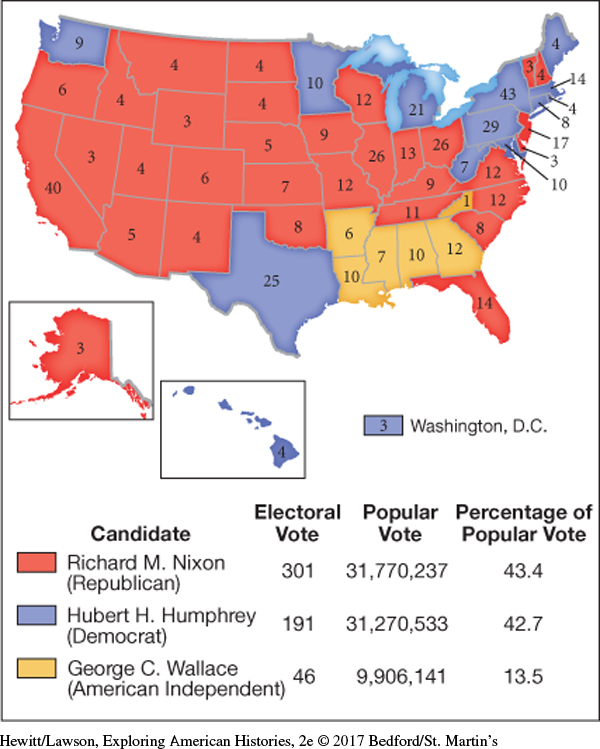The Election of 1968
The year 1968 was a turbulent one. In February, police shot indiscriminately into a crowd gathered for civil rights protests at South Carolina State University in Orangeburg, killing three students. In March, student protests at Columbia University led to a violent confrontation with the New York City police. On April 4, the murder of Martin Luther King Jr. sparked an outburst of rioting by blacks in more than one hundred cities throughout the country. The assassination of Democratic presidential aspirant Robert Kennedy in June further heightened the mood of despair. Adding to the unrest, demonstrators gathered in Chicago in August at the Democratic National Convention to press for an antiwar plank in the party platform. Thousands of protesters were beaten and arrested by Chicago police officers. Many Americans watched in horror as television networks broadcast the bloody clashes, but a majority of viewers sided with the police rather than the protesters.
Similar protests occurred around the world. In early 1968, university students outside Paris protested educational policies and what they perceived as their second-class status. When students at the Sorbonne in Paris joined them in the streets, police attacked them viciously. In June, French president Charles de Gaulle sent in tanks to break up the strikes but also instituted political and economic reforms. Protests also erupted during the spring in Prague, Czechoslovakia, where President Alexander Dubček vowed to reform the Communist regime by initiating “socialism with a human face.” In August the Soviet Union sent its military into Prague to crush the reforms, bringing this brief experiment in freedom remembered as the “Prague Spring” to a violent end. During the same year, student-led demonstrations erupted in Yugoslavia, Poland, West Germany, Italy, Spain, Japan, and Mexico.
Explore
See Document 27.1 for a statement by Richard Nixon on his conservative agenda.
It was against this backdrop of global unrest that Richard Nixon ran for president against the Democratic nominee Hubert H. Humphrey and the independent candidate, George C. Wallace, the segregationist governor of Alabama and a popular archconservative. To outflank Wallace on the right, Nixon declared himself the “law and order” candidate, a phrase that became a code for reining in black militancy. To win southern supporters, he pledged to ease up on enforcing federal civil rights legislation and oppose forced busing to achieve racial integration in schools. He criticized antiwar protesters and promised to end the Vietnam War with honor. Seeking to portray the Democrats as the party of social and cultural radicalism, Nixon geared his campaign message to the “silent majority” of voters—what one political analyst characterized as “the unyoung, the unpoor, and unblack.” This conservative message appealed to many Americans who were fed up with domestic uprisings and war abroad.
Although Nixon won 301 electoral votes, 110 more than Humphrey, none of the three candidates received a majority of the popular vote (see Map 27.1). Yet Nixon and Wallace together garnered about 57 percent of the popular vote, a dramatic shift to the right compared with Lyndon Johnson’s landslide victory just four years earlier. The New Left had given way to an assortment of old and new conservatives, overwhelmingly white, who were determined to contain, if not roll back, the Great Society.

Exploring American HistoriesPrinted Page 898
Exploring American Histories Value EditionPrinted Page 663
Chapter Timeline